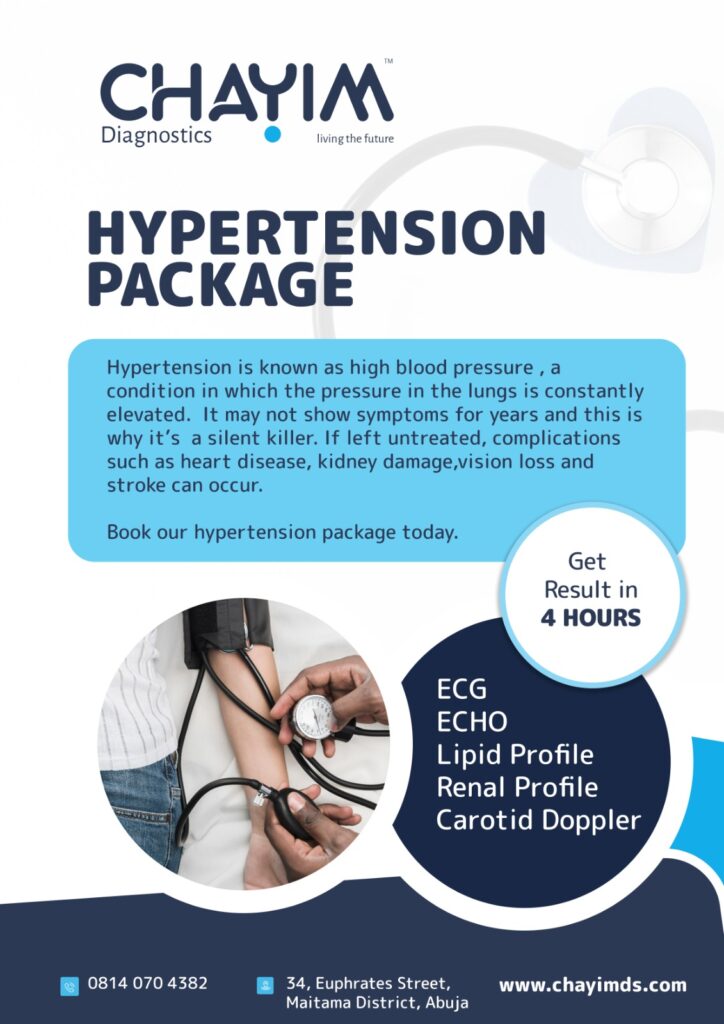HYPERTENSION: KNOW YOUR NUMBERS

Hypertension is known as high blood pressure, a condition in which the pressure in the lungs is constantly elevated above 120/80 mmHg. It is a risk factor for heart disease, stroke, renal complications, and premature death; therefore, it is very important to know your numbers and monitor them closely.
Blood pressure is measured in two numbers:
Systolic pressure:
It is the number shown above in a blood pressure reading. It measures the force exerted on your arteries each time your heart contracts and circulates blood. In a blood pressure reading of 120/80mm/hg, the “120” is the systolic number.
Diastolic pressure:
It is the number shown below in a blood pressure reading. It measures the pressure in your arteries when your heart is at rest between beats. In a blood pressure reading of 120/80mm/hg, the “80” is the diastolic number.
A normal blood pressure is typically defined between 90/60 to 120/80 mmHg. Blood pressure levels lower than 90/60mm/hg are called Hypotension.
Symptoms of Hypertension:
Hypertension may not show symptoms for years, until moderate to severe complications arise hence the reason why it is a silent killer and if left untreated leads to further health complications. Some individuals may experience these symptoms outlined below and even more:
- Headaches
- Dizziness
- Blurred vision
- Fatigue
- Chest pain
- Shortness of breath etc.
Risk factors:
Hypertension can affect anyone regardless of one’s age, but certain factors increase the risk. They include;
- Age: Blood pressure tends to increase with age. People aged 60 and above have an increased risk.
- Genetics: A family history of hypertension increases the likelihood of developing high blood pressure.
- Pregnancy: It has been noticed some women develop hypertension during pregnancy which is known as Preeclampsia (usually occurs in women whose blood pressure had previously been normal) and Post eclampsia (this occurs after delivery as early as 48hours)
- Lifestyle Factors: Eating food high in salt (sodium), fat, and cholesterol, lack of regular physical activity, excessive drinking, smoking tobacco and its derivatives (Vape, shisha, marijuana) increases blood pressure and damages the artery walls.
- Other health complications: Diabetes, lack of sleep, chronic kidney disease and high cholesterol levels can also lead to high blood pressure.
- Obesity: Excess body weight is a major risk for developing hypertension.
- Chronic Stress: Prolonged stress leads to elevated levels of stress hormones such as adrenaline and cortisol. These hormones increase heart rate and blood vessel constriction, contributing to higher blood pressure.
How to check your blood pressure
Checking your blood pressure regularly is the first step to knowing your numbers. Make a habit to check your blood pressure whenever you visit your health provider and for regular monitoring, it is advisable to get a blood pressure monitor.
Here’s a comprehensive guide on how to do it accurately:
- Get a digital blood pressure monitor.
- Ensure you are calm and sit quietly for at least 5 minutes before taking your reading. Avoid smoking, drinking or exercising for at least 30 minutes before taking a measurement.
- Sit upright and place your palm facing up.
- Wrap the cuff around a bare upper arm but let it not be too tight and ensure there is no clothing constricting your arm.
- Once you press the start button on the monitor, the cuff will inflate compressing your arm and then slowly deflate as the measurement is taken.
- Once reading has been taken, the monitor will display your systolic (upper number) and diastolic (lower number) blood pressure readings along with your pulse rate once the measurement is complete.
- Write down your readings along with the date and time of each measurement and ensure to take your blood pressure at the same time each day for consistency. You can take multiple readings and record the average
- Immediately consult your doctor when you notice your numbers are above 120/80mm/hg or below 90/60mm/hg or when your rates are irregular.
It is important to note that:
- A reading of 140/90 mmHg or higher may indicate high blood pressure.
- A reading of 120/80mmHg up to 140/90mmHg may indicate pre-high blood pressure.
- A reading of 90/60mmHg up to 120/80mmHg may indicate high blood pressure.
- A reading of 90/60mmHg or lower may indicate low blood pressure.
Tips to maintain a healthy Blood Pressure
- Exercise regularly.
- Maintain a healthy weight
- Cut back on refined carbohydrates and sugar
- Reduce salt intake.
- Avoid processed food
- Limit alcohol intake and quit smoking.
- Manage stress
- Maintain a good and restful sleep
- Follow a balanced diet
- Reduce caffeine intake
Most importantly, get your blood pressure checked regularly or as prescribed by your health physician. Knowing your numbers is very important when dealing with hypertension.
If you are at risk of hypertension, already hypertensive or would like to take your heart health more seriously, take advantage of our hypertension package which consists of the following parameters:
- ECG & ECHO: These parameters detect changes in heart size, rhythm, and function due to high blood pressure.
- Lipid Profile: Identifies lipid imbalances that increase cardiovascular risk
- Renal Profile: Evaluates kidney function and detects early signs of kidney damage, ensuring timely interventions to prevent further complications from and of hypertension.
- Carotid Doppler: Assesses the risk of stroke by detecting carotid artery disease, a common complication of long-term hypertension.
Visit us today at No 34, Euphrates Street Maitama, Abuja, or give us a call on 08140704382 or send us an email at [email protected] and take a step towards becoming a healthier you.


Responses